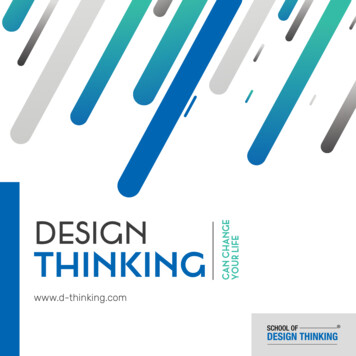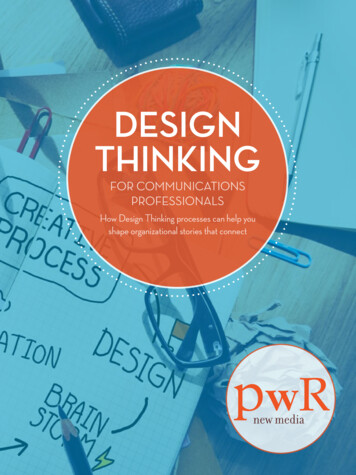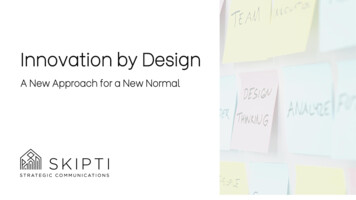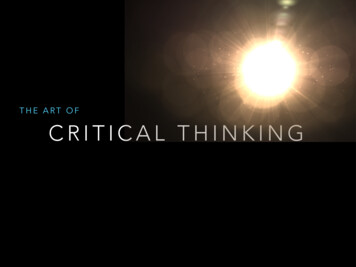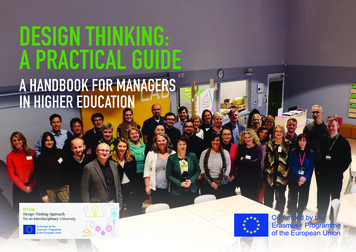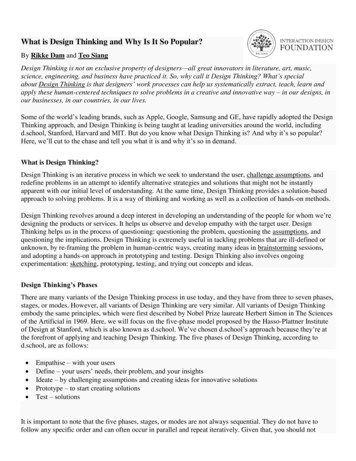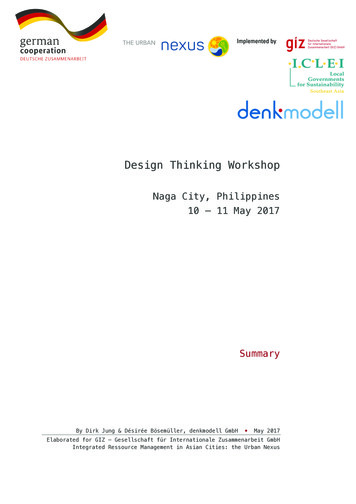
Transcription
Design Thinking WorkshopNaga City, Philippines10 – 11 May 2017SummaryBy Dirk Jung & Désirée Bösemüller, denkmodell GmbH May 2017Elaborated for GIZ – Gesellschaft für Internationale Zusammenarbeit GmbHIntegrated Ressource Management in Asian Cities: the Urban Nexus
Content1Introduction32The methodology: Design Thinking43Team – Millenials6456783.1understand – the Persona63.2understand – Three main needs73.3prototype73.4Iteration of the prototype – Get into the details73.5Final pitch73.6Feedback from the Councilors73.7Further feedback83.8Contact person8Team – Talingkas94.1understand – the Persona94.2understand – Three main needs94.3Iteration of the prototype – Get into the details104.4Prototype / Final pitch104.5Feedback from the Councilors114.6Further feedback114.7Contact person11Team – 3G125.1understand – the Persona125.2understand – Three main needs125.3Iteration of the prototype – Get into the details135.4Prototype / Final pitch135.5Feedback of the Councilors145.6Further feedback145.7Contact person14Team – GO.GANAGUEÑO156.1understand – the Persona156.2understand – Three main needs156.3Iteration of the prototype – Get into the details166.4Prototype / Final pitch166.5Feedback of the Councilors176.6Further Feedback176.7Contact person17Team – Maogmang Lugar 2040187.1understand – the Persona187.2understand – Three main needs187.3Iteration of the prototype – Get into the details197.4Prototype / Final pitch197.5Feedback of the Councilors207.6Further feedback207.7Contact person20General information21GIZ Urban Nexus – Design Thinking Workshop, Naga City1
98.1Feedback sessions218.2General feedback & proposals21Appendix21NoteThis report has been compiled by denkmodell in cooperation with ICLEI. This report may not include all assumptions, hypotheses and interpretations of theworkshop participants made during the Design Thinking workshop. The pictures ofFilipino persons used to create the “persona” might be copyright protected.GIZ Urban Nexus – Design Thinking Workshop, Naga City2
1IntroductionGIZ is implementing the Regional Project “Integrated Resource Management in AsianCities: the Urban Nexus” or – in brief – “GIZ Nexus”. The project is commissionedby German Federal Ministry for Economic Cooperation and Development (BMZ). The political partner of the project is the United Nations Economic and Social Commissionfor Asia and Pacific (UN ESCAP) and the implementation partner is ICLEI SEAS.Within the context of the Urban Nexus Project starting in 2013 over a period ofthree years and a follow-up phase from 2016 to December 2018, twelve South andSouth East Asian partner cities in seven partner countries are provided with technical advice on urban planning and development approaches that include the interrelations and synergies of the sectors: water, energy and food security such as secure water supply and sanitation systems, energy security and efficiency, land use,physical planning and food security.The design thinking workshop taking place in Naga City was realized within the context of the “30 years Sustainable Urban Development Plan for Naga City” (see appendix) which is supported by the GIZ Urban Nexus Project upon request of Naga City.This development plan is derived from the 25 years’ long-term vision entitled “Ambisyon Natin 2040” as guide for developing planning elaborated by the National Economic and Development Authority (NEDA).GIZ Urban Nexus – Design Thinking Workshop, Naga City3
2The methodology: Design ThinkingDesign thinking can be described as a discipline that uses the designer’s sensibility and methods to match people’s needs with whatis technologically feasible and what a viable business strategy canconvert into customer value and market opportunity (Tim Brown,http://designthinking.ideo.com/?p 49).DesirabilityStart with the user!InnovationFeasibilityViabilityDesign Thinkingis a human-centered approach, which is used in order to create innovative products,services or concepts. The Design Thinking process, according to denkmodell, consists of 5 phases:The first two phases (explore and understand) serve to understand the topic indepth – its challenges, its context, its users etc. – however, the last three phases (ideate, prototype and test) serve to create ideas and find solutions for thechallenges or questions, which were identified.The phase explore is the entry point into the process and should be used to developan orientation. The aim is to generate a basic understanding of the topic among theteam members and to come up with a first starting question.Within the understand phase everything is about getting to know and understandingthe user: What are fears, sorrows, needs and dreams? Which perspective has the userregarding the topic? At the end of this phase a “persona” is being created, whichis an archetype (a model of one or several aggregated users) and will help you togain empathy with your users.The phase ideate is about creating as many ideas as possible to tackle the identified needs or problems of the user.GIZ Urban Nexus – Design Thinking Workshop, Naga City4
Prototyping can also be described as „thinking with your hands“. It is about developing cheap, somehow tangible test balloons, whereby critical functions or aspectsof the prototype need to be testable.The test phase with potential end-users is crucial as it entails an evaluation ofthe prototype. Thereafter, one knows whether the prototype needs further adaption,modification or whether it is a complete fail and needs to be thrown away.Furthermore, there are three main success factors for Design Thinking:Multidisciplinary TeamsIterativeProcessFlexibleSpacesIn addition to these aspects one has to focus on several principles in order tocreate a successful Design Thinking process. These principles are: Fail early and often: Learn from your mistakes. It saves money and spursefficiency.Be quick: Use a TimeTimer to put yourself under time pressure. (Longworking hours do not necessarily lead to better results)User-centeredness: No matter what you modify or adapt regarding theprototype, always make sure to create value for the user.Stimulate and use different thinking modes: During the Design Thinkingprocess both, logical-linear and intuitive-unstructured thinking modes arerelevant, but not quite at the same time. At the beginning judgment needsto be deferred otherwise one might miss the innovation.The approach has originally been elaborated by the Stanford University and is welldescribed by this 8 minutes video of the Stanford University.GIZ Urban Nexus – Design Thinking Workshop, Naga City5
The starting question:How can the urban development better satisfy the changing needs ofour citizens in the next 30 years?3Team – Millenialsunderstand – the Persona3.1 Name: AlyanaShy10 years oldPoorWishes:o to be able to eat three times a day,o to finish studieso peaceful and inclusive communityo no traffic, excellent road networko continuous progresso reliable supply of basic serviceso be able to travelo to have a house and a carFamily matters!4P’s Beneficiary – The Pantawid Pamilyang Pilipino Program (4Ps) is a humandevelopment measure of the national government that provides conditionalcash grants to the poorest of the poor, to improve the health, fer/) .Modest homeUncertain futureGIZ Urban Nexus – Design Thinking Workshop, Naga City6
understand – Three main needs3.2 To be safe à to play on the streets outsideTo concentrate at school à to get good marks and make her mum happy andproudTo have good job opportunities in the future à with a university degreeprototype3.3The prototype is based on two main intentions: Immerse children in both, play and studyBuilding stronger bonds between children and parentsIteration of the prototype – Get into the details3.4Key ActivitiesCostCooperationPartnerRevenuePHP 1MBarangay fundFund-raisingprogramsFund generationPHP 1MPrivatetorEntrance feesConstructionPHP 50M per HPSpecialEducationFund (SEF)and Genderand Development(GAD) –deand5yearMpersec-Event feesFinal pitch“Play Hard, Learn More, Grow Better for Everyone” 3.6Accessible and safe public playgrounds with kid-friendly equipment(plastic)Parents’ corner: short talks about family planning and nutrition,livelihood programs; reward points systemMonthly stipend (book allowance, school supplies, meals and snacks) forstudents with honorsMixed study and play timeo 3-5 years old: sleep time play time study timeo 6-12 years old: sleep time play time study timeo 12 years old and above: study time break timeFeedback from the Councilors Main focus: play and studiesBring parents and children closer together for a more holistic developmentNew headline proposal: „Play hard, learn more, live better“A happy kid gives us an excellent citizen and a great leaderGIZ Urban Nexus – Design Thinking Workshop, Naga City7
Remarks: 3.7Further feedback 3.8Councilor Castillo: "might be developing a culture of dependence because wekeep providing stipend; it is the responsibility of the parents to send thekids to school and provide shelter"Rebutall: stipends are treated as rewards for "good deeds" i.e., performingstudentsCouncilor Myles (?): Are we seeing the same feeding programs in 30 years?It has to change. In 30 years, our feeding programs should not be becauseparents cannot feed them; they should serve other purposes such associalization and efficiency. Empowered parents rear happy children.Answer: prototype is supposed to be picked up now to affect Alyana’schildhood on time; the concerned kid will be a working adult in 10 years’time; is part of an investment to the childrenVice Mayor: special parks in some barangays already exist. Lot size ofexisting educare centers is too small (100 sq. m.) to accommodateplaygrounds and other facilities. Should be at least 300 square meters. Weshould consider learning not only inside the classroom but learning throughplaying as well.Regarding the fact that the playground should be entered by both, poor andmiddleclass (rich) children, an entrance fee is not appropriateThere are funding programs à the team needs to work on a convincing conceptIn 30 years from now there may be digital advices involved when it comes tostudying (current lack: internet connection)There could be a design competition at schools – so that the childrendesign their own playgroundKey activities must be identified, which refer to the point of time, oncethe playground is establishedContact personGilbert AlberoTel: 473- 4119E-mail: gilbertalbero@yahoo.comGIZ Urban Nexus – Design Thinking Workshop, Naga City8
4Team – Talingkas4.1understand – the Persona Name: Pepito12 years oldLives in IslaOut of schoolUnstable incomeLikes: hanging out with friends, smoking, instant noodlesGang war involvementNeeds: housing, education, livelihoodBroken family – lives with mother and 4 brothers, is the eldest sonWants to study but no moneyFamily matters a lot to himEJK – refers to extrajudicial killings, an ongoing issue in the Philippineslinked with the national “war on drugs” eviction – this was identified asan issue of Pepito because he has seen friends who were forced to leavetheir houses due to informal settlementIndifferent to city problems but is a member of an out-of-school youth(OSY) organizationunderstand – Three main needs4.2 Permanent, low-cost, comfortable and decent housingFree education until graduation in tertiary level (college)Stable employment for the futureSustainable and stable livelihood for his mother – to support their familyGIZ Urban Nexus – Design Thinking Workshop, Naga City9
Iteration of the prototype – Get into the details4.3Key Activities: Housing – lot acquisition, house construction, site development andmaintenanceEducation – provision of scholarship, procurement and distribution ofschool supplies, provision of student allowanceLivelihood – loans and capital support, trainings, investment promotion andmarketingCooperation Partners: Private sector national government agencies (NGAs)civil society organizations (CSO),and donorsCost:Initial CostYearly CostPHP 30M (housing)PHP 5M (KSK)PHP 15M (education)PHP 5M (Special Education Fund)PHP 10M (livelihood( )PHP 5M (Grow Negosyo)Revenues Amortization (after five years)Grants and donationsTaxesPrototype / Final pitch4.4The prototype is a concept based on the identified needs.“TALINGKAS VILLAGE” Talingkas – Bicol word for “freedom”; liberation of a person from poverty,ignorance, and deprivation of tenureThe village is about community building, not mere organizing (bottom-upinstead of top-down)The program will focus on sustainable housing, holistic education andstrategic, market-driven livelihood (micro and small enterprises)The Talingkas village is a transition stage for the poorest of the poortowards their eventual integration into the mainstream programs andservices (transition from outsiders to integrated citizens)To be piloted in barangays Pacol or Cararayan (target: 100 families)HOUSING – sustainable, resilient, energy-efficient design; equity-basedlabor (build your own)o 0-5 years – free (usufruct) ; 5 years – monthly amortizationo Trust fund to be used for land acquisition (P350 – 500 per squaremeter)o BICAST model as an inspirationEDUCATION – holistic formation of children, emphasis on functionalliteracy, free tuition with complete school facilitieso Existing scholarships and Special Education Fund (SEF)o City College of NagaGIZ Urban Nexus – Design Thinking Workshop, Naga City10
LIVELIHOOD – market-driven micro and small enterprises, upgraded skillsbased livelihood, public-private partnershipso Grow Negosyo Beneficiaries cannot/should not sell the property.In five years, will be hard to remove people in their houses.Answer: After five years, pay or get your house from somewhere else.Within five years, it is expected that the families are able to save.How are existing programs considered in the prototyping? – Upgrade existingprograms through pilots.Stop using the term “livelihood” as it connotes subsistence: challengebeneficiaries to dream / aim higher in terms of empowermentAll enterprises are market-driven. But how do you actually connect themwith the market?4.5Feedback from the Councilors 4.6Further feedback 4.7Key activity within housing will contain security as wellAs it is a bottom-up process, the beneficiaries should be included in theprocess of designing and building the villageContact personAR. Ian Kenneth Orasa & John Barrosa09-19-689013909-21-7331829GIZ Urban Nexus – Design Thinking Workshop, Naga City11
5Team – 3Gunderstand – the Persona5.1 Name: Laura34 years oldWorks in canteenHas children (two kids, one still nursing)Single parentPriority: health of young childrenLives in Lerma with her mother and 5 siblings along the riles (local termfor railroad)She dreams of working abroad as a domestic helperFinancial strugglesPain in her smile à left behind by her husbandShe dreams of having an own house and lot (lot here refers to the landwhere the house is built)Worries: no opportunity to growLikes watching TV and window shopping at SMFavorite dish: adobong manok – if there is extra money; usually eatsnoodles and dried fishunderstand – Three main needs5.2 Livelihood trainingHealthcare program that includes health preventive“security” housingGIZ Urban Nexus – Design Thinking Workshop, Naga City12
Iteration of the prototype – Get into the details5.3Key Activities: Formation of Homeowners’ Association (HOA)Collection and recycling of wasteMaintenance and operation of solar facilityMaintenance of peace and orderCollection of monthly amortizationCooperation Partners: National Housing Authority (NHA)Housing and Land Use Regulatory Board (HLURB)Social Housing Financing C (SHFC)Home Development Mutual Fund (HDMF or PAG-IBIG)Corporate Social Responsibility (SR) funds of private sectorCity GovernmentCost:Assumptions: 3 buildings with 4-storeys each10 households per floor2 units at ground floor for commercial use38 households per building114 households in allUnit Cost / Household: Option A: PHP 743,000 (PHP2,477 per month at 25 years, zero interest)Option B: PHP 568,000 (PHP1,894 per month at 25 years, no interest yet)Cost Components:Option AOption BLotPHP 15,660,000PHP 15,660,000BuildingPHP 69,000,000PHP 49,000,000Parks / PlaygroundPHPPHPTOTALPHP 90,660,0006,000,0006,000,000PHP 70,660,000Revenues: To city government:Option A: PHP3.388M per year at 70% collection efficiency; PHP2.372M peryear excluding interestOption B: PHP2.591M per year at 70% collection efficiency; PHP1.814M peryear excluding interestTo community: income from recyclables, 6 commercial stalls, and monetary savingsfrom solar energy (electricity consumption)Prototype / Final pitch5.4Project Pitch: SOLD NA! (Sustainable Ownership of Livable Dwelling in Naga!) The project is a 4-storey housing project build using low-cost constructiontechnology with tenants generating income from on-site cooperative businessundertakingsGIZ Urban Nexus – Design Thinking Workshop, Naga City13
5.5Feedback of the Councilors 5.6High rise building is not a popular option in PH. Consideration and respectfor others if it means prejudice for our own interest.Naga City can learn from other cities’ mistakes.What policy needs to be put in place in order to make the project moresocially-acceptable?Choosing of beneficiaries is crucial – need to be someone who has capacityto payFurther feedback 5.7It will have community spaces including a park and a playground, recyclingof waste, and partially energized by renewable energyo Ground floor is a commercial space operated by unit owners(cooperative)In short, it is affordable, livable and sustainableVertical / high rise building are at risk to decay, if they are notmaintained properly – external local staff should be hired to maintain thebuilding and additionally the beneficiaries should be trainedThe beneficiaries should be chosen according to specific criteria, whichwill have to be developed carefully (probably not only politicians shouldget involved in the development of such criteria)Learn from other cities success stories, e.g. have a look at verticalgardensInterest of people: to buy land; with this idea there is no opportunity tobuy land (what else could one offer?)Contact personFrank Mendoza473-20-54GIZ Urban Nexus – Design Thinking Workshop, Naga City14
Team – GO.GANAGUEÑO6understand – the Persona6.1 Name: Catherine SY36 years oldAdministrator (principal) in pre-schoolVolunteer (NGO)Owns a carMarriedMonthly income of 35.000Interests: Baking / cooking, pasta, paintingHas a familyPains:o undisciplined drivers,o poor internet connection,o garbage smell,o parking spaces,o traffic,o high taxes,o dirty / polluted river,o small airport,o expensive residentialo neglected street childrenunderstand – Three main needs6.2 Security for the safety of her family and the children in her schoolSafe and convenience transportation to avoid traffic congestion – refers toincreased volume of vehicles in the road resulting to longer travel timesGIZ Urban Nexus – Design Thinking Workshop, Naga City15
and queuing of vehicles (may entail slow movement of vehicles ormovement at all)Competent teachers à more intensive and in-depth trainings for teachersnoIteration of the prototype – Get into the details6.3Key Activities: Transporting passengersMonitoring of operationMaintenance of systemSelling of 00PHP 2MInfrastructurePHP 2MStations (with CCTV)PHP 6MInterconnectionsPHP 1MComputer ProgramPHP 1MElectronic sensors / scannersPHP 2MNew e-jeepsPHP 10MStudyPHP 1MInitial operationg costPHP .5MTOTALPHP 25.5 MRevenues:Gross Income: PHP1,100 x 20 units @ 365 days PHP 8,030,000Less Expenses: Drivers (20)E-jeepOffice staffTotal ExpensesNET INCOMEPHPPHP 3,650,000PHP 3,000,000PHP730,000PHP 7,380,000650,000Cooperation Partners: PaymayaSmart / Globe (telecommunications)Academic institutions: BISCAST,architecture)ChurchGAD – Gender and DevelopmentDRR (disaster risk reduction)UNC,AdNU,USI,NCF(electronics/Prototype / Final pitch6.4“Systemic, eco-friendly transportation with a tourist twist” Provide a systemic, eco-friendly transportationGIZ Urban Nexus – Design Thinking Workshop, Naga City16
6.5Attract tourists to Naga as educationalcapitalEvery Nagueno is a tourist guidecenter,pilgrimagecity,foodFeedback of the Councilors 6.6Is a good principle, ideas like the loading and unloading station has beensurfaced before. However, this will displace those whose livelihoods dependon transport (i.e., jeepney drivers, tricycle drivers).Universities can be tapped as initial partnersImplementation of this will need policy support especially the phase-out ofjeepneysSustainable transport and this one has same aspects and maybe we could seeif we can link these two togetherWhat is unique here is that there is premium in utilizing e-jeeps and haveidentified universities as early adoptersCouncilor Myles: Idea of making every nagueno as a tour guide (tourismaspect) is appealing. This means that everyone really knows their city.Further Feedback 6.7This idea can be easily combined with Maogmang Lugar 2040It is about changing habits, which may need time and patienceContact personEngr. Victor RevillaBISCAST 63920 840 0215GIZ Urban Nexus – Design Thinking Workshop, Naga City17
7Team – Maogmang Lugar 2040understand – the Persona7.1 Name: Jose „Jo“His wife is Melissa – she is not so optimistic, Jose is an optimist27 years oldHas a child, 3 years oldLives in a sub urban areaJeepney driverLives with his parents and 3 other siblingsKaantabay sa Kauswagan (KSK) Program – program for the urban poor focusedon providing land tenureLikes: Drinking, Bicol, LaingHas no savings for health careDoesn’t have a stable jobMeans to take care of aging parentsWisheso Better livelihood programso Health programso Housing programso Improved public transporto Active people participation through the peoples councilo Free immunizationInflation – prices of commoditiesIllnessunderstand – Three main needs7.2 Ordinances / polices to address traffic problemsStable income à own a jeepney (savings for emergency needs, providing theneeds of the family, education for the children)GIZ Urban Nexus – Design Thinking Workshop, Naga City18
Iteration of the prototype – Get into the details7.3Key activities: Regular scheduled tripsAccessible and safe parking spacesAvailable alternative mode of public transportProvide a safe recreation area for the publicProviding a variety of mobility modesPedestrianization of CBDCooperation partners: National agenciesDPWHUnU (CNO, SP)SCOTransport sectorRiding publicDOTR (LTD, LTFRS)Financing agenciesCosts E-Jeep / unitMulti-level carportRoad improvement & underground utilitiesPHP 100 MillionPHP 400 MillionPHP 100 MillionRevenues E-Jeeps recoverable in 5 yearsMulti-level parkingRenting utilitiesRoad boardsBetterment Lev9PHP 1 MillionPHP 20 MillionPrototype / Final pitch7.4“Sustainable urban transport system” – Imagine the CBD as Naga City’s MOA or SMNorth Sustainable train transport systemImagine the Central Business District 1 as Naga City’s SM MOA or SM NorthEDSA.Supports variety of transport modes by providing delineated roads formotorized and non-motorized movementHigh preference for public transport regardless of economic statusIntroduction of a single public transport organization where drivers aresalary-based and public utility jeepneys (PUJs) are replaced by e-Jeeps(run by electricity).Key Features: Use of push carts in pedestrian areasFinancing of e-jeeps by the national government with the private sectorNew policies for new transport systemLoading and unloading @ the Integrated Terminal / Multi-level ParkingRight of Way: Pedestrian district for delivery and emergency onlyDrivers are salary-based.Efficient traffic systemGIZ Urban Nexus – Design Thinking Workshop, Naga City19
7.5wiring”–pansitFeedback of the Councilors 7.6Political will: convert public market with multi-level parkingProblem will rest with elected officials if there will be a need todemolish existing infra - clarified that there will not be demolition; ideais that ground floor will serve as parking for intra-city routesAuthorize a policy that parking is not a right but a privilege. Discourageparking by private property owners. This is a way to modify behavior ofprivate vehicle owners.Forthcoming constructions of Robinsons and Alimall need to be considered.One operator per route - rationalized dispatchWhat to do with old units and existing operators?transition toward better kind of vehicleno displacement as it may create social unrestLTFRB plays an important role here.Will allow scheduled services of jeepneysImplement changes in CBD 1 - make it a walking area with appropriate infrasupportFurther feedback 7.7Defined windows for deliveriesEnhanced urban green spacesReduction of carbon emissionsImproved vista (overall view): “elimination of pansitrefers to criss-crossing cables for electric postsHow to ensure that the different drivers stick to their specific lane?In a growing city you have to start now to get the trafficContact personWilfredo Prilles Jr.cpdo@naga.gov.ph908-8619441GIZ Urban Nexus – Design Thinking Workshop, Naga City20
8General information8.1Feedback sessions 8.2The final pitches were judged by the Vice-Mayor and the City CouncilThe jury selected Team 3G as the winner teamIn addition to the Vice-Major and the City Council about 10 externalobservers (SPES students, an architect and an engineer) gave feedback onthe prototypeso When the facilitator of this workshop asked two observers for theirfavorite prototype both agreed on Talingkas and Team 3G, due to thefacts that people need livelihood and that there area number ofinformal settlers in Naga hence these prototypes are more applicableGeneral feedback & proposals 9Naga is a walkable city, maximize the use of riverWalkable city tourist attraction feasibility for business moreopportunitiesIllegal settlers in Centro need to be transferred.Every year, population is growing hence there is a gap in housing.Suggestion: urban re-planning – urban parks are better for the community.Not just focus on Naga City (it is quite small). Think bigger - Metro Naga(to include Milaor and other neighboring LGUs).Naga in 30 years: The size will have changed massively, so, do not thinkabout Naga City in the size it exists now but add the surrounding areas inyour prototypesAppendix Photo Documentation of the design thinking workshop in Naga City (pdf)The “30 years Sustainable Urban Development Plan” for Naga CityAmbisyon (where the “30 years Sustainable Urban Development Plan” is derivedfrom)GIZ Urban Nexus – Design Thinking Workshop, Naga City21
denkmodell GmbH Pfuelstraße 510997 BerlinGermanyTelFaxE-MailWeb 49 30 690 488 0 49 30 690 488 99berlin@denkmodell.dewww.denkmodell.de/en
17-007Photo Documentation – GIZ Urban NexusDesign Thinking WorkshopDirk Jung, Désirée Bösemüller10 & 11 May 2017, Naga City, Philippinesdenkmodell GmbHPfuelstraße 510997 BerlinGermanywww.denkmodell.deTel 49-30-690488-0Fax 49-30-690488-99berlin@denkmodell.de
essionsThanks
pImpressionsThanks
AgendaInputsOpeningSpeechesThe Design Thinking Process4TeamsWorkshopImpressionsThanks
AgendaInputsOpeningSpeechesTeamsThe Design Thinking Process - explore5WorkshopImpressionsThanks
sThe Design Thinking Process – understandTask:6Thanks
AgendaInputsOpeningSpeechesTeamsThe Design Thinking Process – ideateBrainstorming question:Brainstorming methods:7WorkshopImpressionsThanks
AgendaOpeningSpeechesInputsTeamsThe Design Thinking Process – prototypeTasks:8WorkshopImpressionsThanks
AgendaInputsOpeningSpeechesTeamsThe Design Thinking Process – test9WorkshopImpressionsThanks
sThanksWarm-Up showing the multidisciplinarity of the group10
AgendaInputsOpening hanks
AgendaInputsTeam MillenialsTeam 1Team 2Team 3Team 4Team 512OpeningSpeechesTeamsWorkshopImpressionsThanks
AgendaInputsOpeningSpeechesunderstand – PersonaTeam 1Team 2Team 3Team 4Team 513TeamsWorkshopImpressionsThanks
AgendaInputsOpeningSpeechesTeamsunderstand – Three main needsTeam 1Team 2Team 3Team 4Team 514WorkshopImpressionsThanks
AgendaInputsideate – IdeasTeam 1Team 2Team 3Team 4Team 515OpeningSpeechesTeamsWorkshopImpressionsThanks
AgendaprototypeTeam 1Team 2Team 3Team 4Team anks
AgendaInputsOpeningSpeechestest – with external guestsTeam 1Team 2Team 3Team 4Team 517TeamsWorkshopImpressionsThanks
sIteration of the prototype – get into the details Team 1Team 2Team 3Team 4Team 518Thanks
AgendaInputsFinal prototypeTeam 1Team 2Team 3Team 4Team 519OpeningSpeechesTeamsWorkshopImpressionsThanks
AgendaInputsOpeningSpeechesFinal presentation (5 min pitch)Team 1Team 2Team 3Team 4Team 520TeamsWorkshopImpressionsThanks
AgendaInputsContact personTeam 1Team 2Team 3Team 4Team 521OpeningSpeechesTeamsWorkshopImpressionsThanks
AgendaInputsTeam TalingkasTeam 1Team 2Team 3Team 4Team 522OpeningSpeechesTeamsWorkshopImpressionsThanks
AgendaInputsOpeningSpeechesunderstand – PersonaTeam 1Team 2Team 3Team 4Team 523TeamsWorkshopImpressionsThanks
AgendaInputsOpeningSpeechesTeamsunderstand – Three main needsTeam 1Team
The design thinking workshop taking place in Naga City was realized within the con- text of the “30 years Sustainable Urban Development Plan for Naga City” (see appen- dix) which is supported

